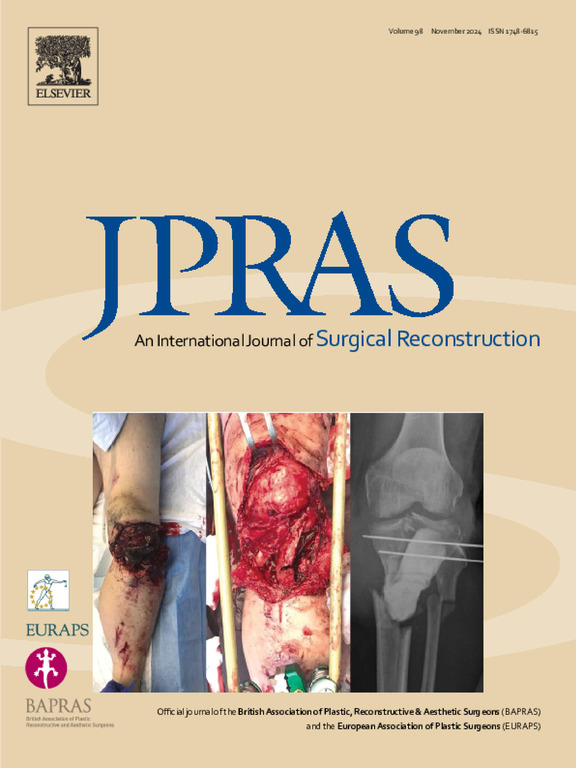脱细胞真皮基质在水凝胶支架中的整合:软骨组织工程的新方法
IF 2
3区 医学
Q2 SURGERY
Journal of Plastic Reconstructive and Aesthetic Surgery
Pub Date : 2025-06-03
DOI:10.1016/j.bjps.2025.05.038
引用次数: 0
摘要
支架材料影响工程软骨的性能,但目前的选择,如水凝胶和PCL有局限性,包括强度不足和炎症反应。本研究探讨了水凝胶支架与脱细胞真皮基质(ADM)结合增强结构完整性和软骨形成的功效。方法取人第三肋软骨,分离软骨细胞,用流式细胞术检测其表面标志物(CD44、CD54、CD31、CD45)。用明胶支架(ADM组)或不含ADM片(水凝胶组)培养软骨细胞,植入BALB/c裸鼠体内12周。对收获的构建体进行组织学染色和ECM分析,包括GAG和II型胶原ELISA。结果与水凝胶组相比,ADM组较好地保留了组织的矩形形状,收缩和变形较小。ADM组支架宽度(9.20±0.23 mm)明显大于水凝胶组(7.40±0.93 mm, p < 0.05)。组织学分析显示,ADM组ECM形成增强,ECM分布均匀。定量分析显示,ADM组的糖胺聚糖含量(3.3±0.7 μg/mg)和II型胶原含量(11.3±1.6 μg/mg)显著高于水凝胶组(2.2±0.2 μg/mg和4.6±0.4 μg/mg);术中,0.05)。结论与纯水凝胶支架相比,adm覆盖的水凝胶支架在体内有效地保持了其结构完整性和体积,促进了ECM的产生。这些发现表明adm覆盖的水凝胶支架在软骨组织工程和重建手术中具有重要的潜力。本文章由计算机程序翻译,如有差异,请以英文原文为准。
Acellular dermal matrix integration in hydrogel scaffolds: A novel approach to cartilage tissue engineering
Background
Scaffold materials impact engineered cartilage properties, but current options like hydrogels and PCL have limitations, including insufficient strength and inflammatory responses. This study explored the efficacy of integrating hydrogel scaffolds with an acellular dermal matrix (ADM) to enhance structural integrity and chondrogenesis.
Methods
Human third costal cartilage was obtained and processed to isolate chondrocytes, which were assessed via flow cytometry for surface markers (CD44, CD54, CD31, CD45). Chondrocytes were cultured in a gelatin scaffold with (ADM group) or without ADM sheets (Hydrogel group), then implanted in BALB/c nude mice for 12 weeks. Histological staining and ECM analyses, including GAG and type II collagen ELISA, were conducted on harvested constructs.
Results
The rectangular shape was better preserved in the ADM group compared to the hydrogel group, indicating less contraction and deformation. The scaffold width in the ADM group was significantly greater (9.20±0.23 mm) than that in the hydrogel group (7.40±0.93 mm, p<0.05). Histological analysis revealed an enhanced ECM formation in the ADM group with uniform ECM distribution. The quantitative assays demonstrated significantly higher glycosaminoglycan content (3.3±0.7 μg/mg) and type II collagen levels (11.3±1.6 μg/mg) in the ADM group compared to the hydrogel group (2.2±0.2 μg/mg and 4.6±0.4 μg/mg, respectively; p<0.05).
Conclusion
The ADM-covered hydrogel scaffold effectively maintained its structural integrity and volume in vivo, promoting ECM production compared with the hydrogel-only scaffold. These findings indicate that the ADM-covered hydrogel scaffolds have significant potential for cartilage tissue engineering and reconstructive surgery.
求助全文
通过发布文献求助,成功后即可免费获取论文全文。
去求助
来源期刊
CiteScore
3.10
自引率
11.10%
发文量
578
审稿时长
3.5 months
期刊介绍:
JPRAS An International Journal of Surgical Reconstruction is one of the world''s leading international journals, covering all the reconstructive and aesthetic aspects of plastic surgery.
The journal presents the latest surgical procedures with audit and outcome studies of new and established techniques in plastic surgery including: cleft lip and palate and other heads and neck surgery, hand surgery, lower limb trauma, burns, skin cancer, breast surgery and aesthetic surgery.

 求助内容:
求助内容: 应助结果提醒方式:
应助结果提醒方式:


